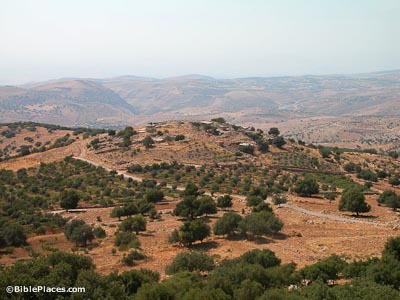 |
| site of Tishbi in Gilead, home of the Prophet Elijah, courtesy, BiblePlaces.com |
During the Islamic period, the territories on the east side
of the Jordan, being so close to the Arabian Desert, were one of the first of
the ancient Israelite territories to be settled by Arab tribes, and throughout
the centuries, both Arab and Jewish Bedouin would traverse the area.
Ajlun (the Arabic name for Gilead) was an important Jewish
center in the Middle Ages. In the 12th century, the Spanish
Jewish traveler and explorer Benjamin of Tudela wrote of a Jewish community in
Ajlun with a population of 60 families lead by three sheikhs – Zadok, Yitzhak,
and Shlomo. For a period of time, the rabbis of Jerusalem debated whether
certain parts of the territories east of the Jordan, including Ajlun, were part
of the Land of Israel according to halacha, and therefore subject to the laws
that can only be observed in Israel. People often expressed their opinions, but
one opinion that carried much weight was that of the Palestinian geographer
Ashturi HaParhi who considered the town as part of Israel. The matter was
finally settled at the end of the 16th century when Ajlun,
along with other towns in the area, were officially considered a part of Israel
according to halacha. (NOTE: At that time, whether a rabbinic authority was pro
or con, no one even discussed the possibility of uprooting Jews from there. And
the Jews from there never said that they were there in order to protect Jaffa.)
In 1879, the region was proposed as a place of Jewish
settlement by the English adventurer Laurence Oliphant. By that time, Ajlun had
long been abandoned but there was still an intermittent Jewish presence in the
region among the local Bedouin. Many Jews would come to Jerash, for example, for trade making that town, a major commercial
center, a status it retained until the 1920s.
In the 1890s, one of the earliest halutzim, Isaiah
Rafalovich, lived for a while in es Salt.
During World War I, the Battle of es Salt, one of many battles that were fought
in the Gilead region, and fought between the Turks and the Jewish Legion, was
among the most decisive battles in the War that allowed the British to take
control of Palestine. When the British authorities created Transjordan in 1922,
the territories east of the Jordan, including Gilead, became off limits to
Jews. Today, in spite of the peace treaty with Jordan, the ban on Jewish
residency in the area is still in force.
No comments:
Post a Comment